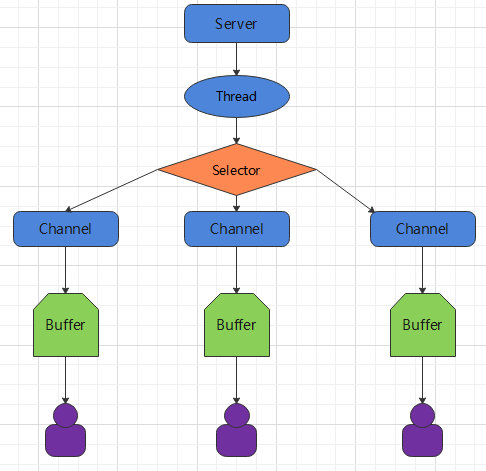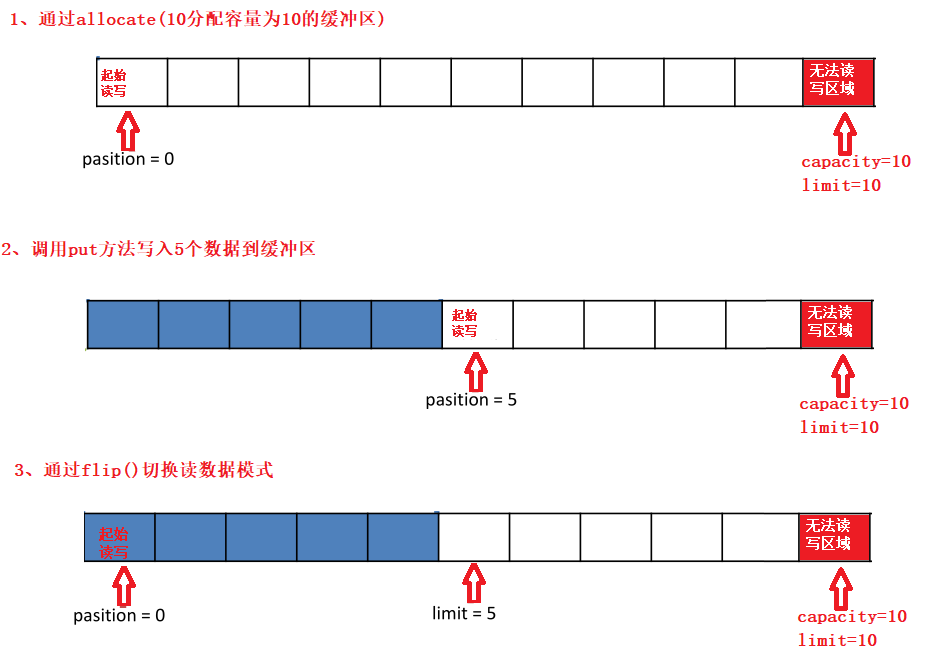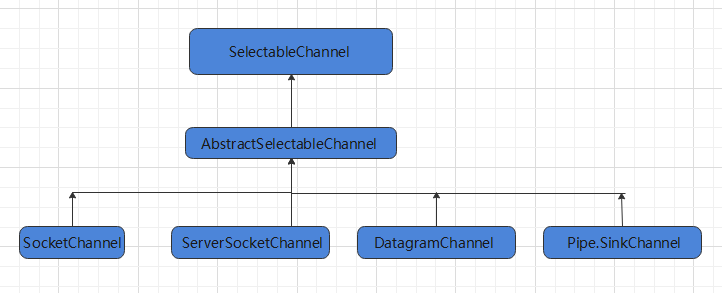NIO+BIO+AIO.Java教程之IO模式精讲.黑马跟学(二)

这里写目录标题
- 第四章 JAVA NIO深入剖析
-
- 4.1 Java NIO 基本介绍
- 4.2 NIO 和 BIO 的比较
- 4.3 NIO 三大核心原理示意图
- 4.4 NIO核心一:缓冲区(Buffer)
-
- 缓冲区(Buffer)
- Buffer 类及其子类
- 缓冲区的基本属性
- Buffer常见方法
- 缓冲区的数据操作
- 案例演示
- 直接与非直接缓冲区
- 4.5 NIO核心二:通道(Channel)
-
- 通道Channe概述
- 常用的Channel实现类
- FileChannel 类
- FileChannel的常用方法
- 案例1-本地文件写数据
- 案例2-本地文件读数据
- 案例3-使用Buffer完成文件复制
- 案例4-分散 (Scatter) 和聚集 (Gather)
- 案例5-transferFrom()
- 案例6-transferTo()
- 4.6 NIO核心三:选择器(Selector)
-
- 选择器(Selector)概述
- 选择器(Selector)的应用
- 4.7 NIO非阻塞式网络通信原理分析
-
- Selector 示意图和特点说明
- 服务端流程
- 客户端流程
- 4.8 NIO非阻塞式网络通信入门案例
-
- 代码案例
- 4.9 NIO 网络编程应用实例-群聊系统
-
- 目标
- 服务端代码实现
- 客户端代码实现
- 小结
- 第五章 JAVA AIO深入剖析
-
- 5.1 AIO编程
- 第六章 BIO,NIO,AIO课程总结
第四章 JAVA NIO深入剖析
在讲解利用NIO实现通信架构之前,我们需要先来了解一下NIO的基本特点和使用。
4.1 Java NIO 基本介绍
-
Java NIO(New IO)也有人称之为 java non-blocking IO是从Java 1.4版本开始引入的一个新的IO API,可以替代标准的Java IO API。NIO与原来的IO有同样的作用和目的,但是使用的方式完全不同,NIO支持面向缓冲区的、基于通道的IO操作。NIO将以更加高效的方式进行文件的读写操作。NIO可以理解为非阻塞IO,传统的IO的read和write只能阻塞执行,线程在读写IO期间不能干其他事情,比如调用socket.read()时,如果服务器一直没有数据传输过来,线程就一直阻塞,而NIO中可以配置socket为非阻塞模式。
-
NIO 相关类都被放在 java.nio 包及子包下,并且对原 java.io 包中的很多类进行改写。
-
NIO 有三大核心部分:Channel( 通道) ,Buffer( 缓冲区), Selector( 选择器)
-
Java NIO 的非阻塞模式,使一个线程从某通道发送请求或者读取数据,但是它仅能得到目前可用的数据,如果目前没有数据可用时,就什么都不会获取,而不是保持线程阻塞,所以直至数据变的可以读取之前,该线程可以继续做其他的事情。 非阻塞写也是如此,一个线程请求写入一些数据到某通道,但不需要等待它完全写入,这个线程同时可以去做别的事情。
-
通俗理解:NIO 是可以做到用一个线程来处理多个操作的。假设有 1000 个请求过来,根据实际情况,可以分配20或者80个线程来处理。不像之前的阻塞 IO 那样,非得分配 1000 个。
4.2 NIO 和 BIO 的比较
- BIO 以流的方式处理数据,而 NIO 以块的方式处理数据,块 I/O 的效率比流 I/O 高很多
- BIO 是阻塞的,NIO 则是非阻塞的
- BIO 基于字节流和字符流进行操作,而 NIO 基于 Channel(通道)和 Buffer(缓冲区)进行操作,数据总是从通道读取到缓冲区中,或者从缓冲区写入到通道中。Selector(选择器)用于监听多个通道的事件(比如:连接请求,数据到达等),因此使用单个线程就可以监听多个客户端通道。
| NIO | BIO |
|---|---|
| 面向缓冲区(Buffer) | 面向流(Stream) |
| 非阻塞(Non Blocking IO) | 阻塞IO(Blocking IO) |
| 选择器(Selectors) |
4.3 NIO 三大核心原理示意图
NIO 有三大核心部分:Channel( 通道) ,Buffer( 缓冲区), Selector( 选择器)
Buffer缓冲区
缓冲区本质上是一块可以写入数据,然后可以从中读取数据的内存。这块内存被包装成NIO Buffer对象,并提供了一组方法,用来方便的访问该块内存。相比较直接对数组的操作,Buffer API更加容易操作和管理。
Channel(通道)
Java NIO的通道类似流,但又有些不同:既可以从通道中读取数据,又可以写数据到通道。但流的(input或output)读写通常是单向的。 通道可以非阻塞读取和写入通道,通道可以支持读取或写入缓冲区,也支持异步地读写。
Selector选择器
Selector是 一个Java NIO组件,可以能够检查一个或多个 NIO 通道,并确定哪些通道已经准备好进行读取或写入。这样,一个单独的线程可以管理多个channel,从而管理多个网络连接,提高效率。

- 每个 channel 都会对应一个 Buffer。
- 一个线程对应Selector , 一个Selector对应多个 channel(连接)。
- 程序切换到哪个 channel 是由事件决定的。
- Selector 会根据不同的事件,在各个通道上切换。
- Buffer 就是一个内存块 , 底层是一个数组。
- 数据的读取写入是通过 Buffer完成的 , BIO 中要么是输入流,或者是输出流, 不能双向,但是 NIO 的 Buffer 是可以读也可以写。
- Java NIO系统的核心在于:通道(Channel)和缓冲区 (Buffer)。通道表示打开到 IO 设备(例如:文件、 套接字)的连接。若需要使用 NIO 系统,需要获取用于连接 IO 设备的通道以及用于容纳数据的缓冲区。然后操作缓冲区,对数据进行处理。简而言之,Channel 负责传输, Buffer 负责存取数据。
4.4 NIO核心一:缓冲区(Buffer)
缓冲区(Buffer)
一个用于特定基本数据类 型的容器。由 java.nio 包定义的,所有缓冲区都是 Buffer抽象类的子类。Java NIO 中的 Buffer 主要用于与 NIO 通道进行 交互,数据是从通道读入缓冲区,从缓冲区写入通道中的。

Buffer 类及其子类
Buffer 就像一个数组,可以保存多个相同类型的数据。根 据数据类型不同 ,有以下 Buffer 常用子类:
- ByteBuffer
- CharBuffer
- ShortBuffer
- IntBuffer
- LongBuffer
- FloatBuffer
- DoubleBuffer
上述 Buffer 类 他们都采用相似的方法进行管理数据,只是各自管理的数据类型不同而已。都是通过如下方法获取一个 Buffer 对象:
static XxxBuffer allocate(int capacity) : 创建一个容量为capacity 的 XxxBuffer 对象
缓冲区的基本属性
Buffer 中的重要概念:
- 容量 (capacity) :作为一个内存块,Buffer具有一定的固定大小,也称为"容量",缓冲区容量不能为负,并且创建后不能更改。
- 限制 (limit):表示缓冲区中可以操作数据的大小(limit 后数据不能进行读写)。缓冲区的限制不能为负,并且不能大于其容量。 写入模式,限制等于buffer的容量。读取模式下,limit等于写入的数据量。
- 位置 (position):下一个要读取或写入的数据的索引。缓冲区的位置不能为负,并且不能大于其限制。
- 标记 (mark)与重置 (reset):标记是一个索引,通过 Buffer 中的 mark() 方法 指定 Buffer 中一个特定的 position,之后可以通过调用 reset() 方法恢复到这个position.
标记、位置、限制、容量遵守以下不变式: 0 <= mark <= position <= limit <= capacity - 图示:
可以看到是从0开始计数的。

Buffer常见方法
Buffer clear() 清空缓冲区并返回对缓冲区的引用
Buffer flip() 将缓冲区的界限设置为当前位置,并将当前位置重置为 0
int capacity() 返回 Buffer 的 capacity 大小
boolean hasRemaining() 判断缓冲区中是否还有元素
int limit() 返回Buffer的界限(limit) 的位置
Buffer limit(int n) 将设置缓冲区界限为 n, 并返回一个具有新limit的缓冲区对象
Buffer mark() 对缓冲区设置标记
int position() 返回缓冲区的当前位置position
Buffer position(int n) 将设置缓冲区的当前位置为n,并返回修改后的Buffer对象
int remaining() 返回 position 和 limit 之间的元素个数
Buffer reset() 将位置 position 转到以前设置的 mark 所在的位置
Buffer rewind() 将位置设为为 0, 取消设置的 mark
缓冲区的数据操作
Buffer 所有子类提供了两个用于数据操作的方法:get()、put()方法获取Buffer中的数据
get() :读取单个字节
get(byte[] dst):批量读取多个字节到 dst 中
get(int index):读取指定索引位置的字节(不会移动 position)放入到数据Buffer中
put(byte b):将给定单个字节写入缓冲区的当前位置
put(byte[] src):将 src 中的字节写入缓冲区的当前位置
put(int index, byte b):将指定字节写入缓冲区的索引位置(不会移动position)
使用Buffer读写数据一般遵循以下四个步骤:
- 1.写入数据到Buffer
- 2.调用flip()方法,转换为读取模式
- 3.从Buffer中读取数据
- 4.调用buffer.clear()方法或者buffer.compact()方法清除缓冲区
新建Module
Module name: nio_buffer

新建类

案例演示
API简单应用
BufferTest.java
public class BufferTest {@Testpublic void test01() {// 1.分配一个缓冲区,容量是10ByteBuffer buffer = ByteBuffer.allocate(10);// 2.System.out.println("当前缓冲区的起始位置:" + buffer.position()); // 0System.out.println("当前缓冲器的限制位置:" + buffer.limit()); // 10System.out.println("当前缓冲器的容量:" + buffer.capacity()); // 10System.out.println("------------------------------");// 3.缓冲区中添加数据String name = "itheima";buffer.put(name.getBytes());System.out.println("put后缓冲区的起始位置:" + buffer.position()); // 7System.out.println("put后缓冲器的限制位置:" + buffer.limit()); // 10System.out.println("put后缓冲器的容量:" + buffer.capacity()); // 10System.out.println("------------------------------");// 4.flip()方法 将缓冲区的界限设置为当前位置,并将当前位置重置为0 可读模式buffer.flip();System.out.println("flip后缓冲区的起始位置:" + buffer.position()); // 0System.out.println("flip后缓冲器的限制位置:" + buffer.limit()); // 7System.out.println("flip后缓冲器的容量:" + buffer.capacity()); // 10System.out.println("------------------------------");// 5. get读取数据char ch = (char) buffer.get();System.out.println("字符ch:" + ch); // iSystem.out.println("get后缓冲区的起始位置:" + buffer.position()); // 1System.out.println("get后缓冲器的限制位置:" + buffer.limit()); // 7System.out.println("get后缓冲器的容量:" + buffer.capacity()); // 10}
}
输出结果:
当前缓冲区的起始位置:0
当前缓冲器的限制位置:10
当前缓冲器的容量:10
------------------------------
put后缓冲区的起始位置:7
put后缓冲器的限制位置:10
put后缓冲器的容量:10
------------------------------
flip后缓冲区的起始位置:0
flip后缓冲器的限制位置:7
flip后缓冲器的容量:10
------------------------------
字符ch:i
get后缓冲区的起始位置:1
get后缓冲器的限制位置:7
get后缓冲器的容量:10
API简单应用2
BufferTest.java
@Testpublic void test02() {// 1.分配一个缓冲区容量为10ByteBuffer byteBuffer = ByteBuffer.allocate(10);System.out.println("缓冲区的起始位置:" + byteBuffer.position()); // 0System.out.println("缓冲区的限制位置:" + byteBuffer.limit()); // 10System.out.println("缓冲区的容量:" + byteBuffer.capacity()); // 10System.out.println("------------------------------");String name = "itheima";byteBuffer.put(name.getBytes());System.out.println("put后缓冲区的起始位置:" + byteBuffer.position()); // 7System.out.println("put后缓冲区的限制位置:" + byteBuffer.limit()); // 10System.out.println("put后缓冲区的容量:" + byteBuffer.capacity()); // 10System.out.println("------------------------------");// 2.清除缓冲区byteBuffer.clear();System.out.println("clear后缓冲区的起始位置:" + byteBuffer.position()); // 0System.out.println("clear后缓冲区的限制位置:" + byteBuffer.limit()); // 10System.out.println("clear后缓冲区的容量:" + byteBuffer.capacity()); // 10System.out.println((char) byteBuffer.get()); // i 这里并不会清除,而只是把position变回了0,覆盖写操作才会清除原有数据System.out.println("------------------------------");}
输出结果:
缓冲区的起始位置:0
缓冲区的限制位置:10
缓冲区的容量:10
------------------------------
put后缓冲区的起始位置:7
put后缓冲区的限制位置:10
put后缓冲区的容量:10
------------------------------
clear后缓冲区的起始位置:0
clear后缓冲区的限制位置:10
clear后缓冲区的容量:10
i
API简单应用3
BufferTest.java
@Testpublic void test03() {// 3.定义一个缓冲区String name = "itheima";ByteBuffer byteBuffer = ByteBuffer.allocate(10);byteBuffer.put(name.getBytes());byteBuffer.flip();// 读取数据byte[] bytes = new byte[2];byteBuffer.get(bytes);String rs = new String(bytes);System.out.println(rs); // itSystem.out.println("当前缓冲区的起始位置:" + byteBuffer.position()); // 2 说明读取了前2个位置了(0,1),这个时候从第3个位置2开始System.out.println("当前缓冲区的限制位置:" + byteBuffer.limit()); // 7 itheima flip之后,前7个位置可以读取System.out.println("当前缓冲区的容量:" + byteBuffer.capacity()); // 10System.out.println("------------------------------");// markbyteBuffer.mark(); // 标记此刻的位置2byte[] bs = new byte[3];byteBuffer.get(bs);System.out.println(new String(bs)); // heiSystem.out.println("当前缓冲区的起始位置:" + byteBuffer.position()); // 5System.out.println("当前缓冲区的限制位置:" + byteBuffer.limit()); // 7System.out.println("当前缓冲区的容量:" + byteBuffer.capacity()); // 10System.out.println((char) byteBuffer.get()); // mSystem.out.println("------------------------------");// resetbyteBuffer.reset();if (byteBuffer.hasRemaining()) {System.out.println(byteBuffer.remaining()); // 5}}
输出结果:
it
当前缓冲区的起始位置:2
当前缓冲区的限制位置:7
当前缓冲区的容量:10
------------------------------
hei
当前缓冲区的起始位置:5
当前缓冲区的限制位置:7
当前缓冲区的容量:10
m
------------------------------
5
直接与非直接缓冲区
什么是直接内存与非直接内存
根据官方文档的描述:
byte byffer可以是两种类型,一种是基于直接内存(也就是非堆内存);另一种是非直接内存(也就是堆内存)。对于直接内存来说,JVM将会在IO操作上具有更高的性能,因为它直接作用于本地系统的IO操作。而非直接内存,也就是堆内存中的数据,如果要做IO操作,会先从本进程内存复制到直接内存,再利用本地IO处理。
从数据流的角度,非直接内存是下面这样的作用链:
本地IO-->直接内存-->非直接内存-->直接内存-->本地IO
而直接内存是:
本地IO-->直接内存-->本地IO
很明显,在做IO处理时,比如网络发送大量数据时,直接内存会具有更高的效率。直接内存使用allocateDirect创建,但是它比申请普通的堆内存需要耗费更高的性能。不过,这部分的数据是在JVM之外的,因此它不会占用应用的内存。所以呢,当你有很大的数据要缓存,并且它的生命周期又很长,那么就比较适合使用直接内存。只是一般来说,如果不是能带来很明显的性能提升,还是推荐直接使用堆内存。字节缓冲区是直接缓冲区还是非直接缓冲区可通过调用其 isDirect() 方法来确定。
使用场景
- 1 有很大的数据需要存储,它的生命周期又很长。
- 2 适合频繁的IO操作,比如网络并发场景。
4.5 NIO核心二:通道(Channel)
通道Channe概述
通道(Channel):由 java.nio.channels 包定义 的。Channel 表示 IO 源与目标打开的连接。 Channel 类似于传统的“流”。只不过 Channel 本身不能直接访问数据,Channel 只能与 Buffer 进行交互。
1、 NIO 的通道类似于流,但有些区别如下:
-
通道可以同时进行读写,而流只能读或者只能写
-
通道可以实现异步读写数据
-
通道可以从缓冲读数据,也可以写数据到缓冲:
2、BIO 中的 stream 是单向的,例如 FileInputStream 对象只能进行读取数据的操作,而 NIO 中的通道(Channel)是双向的,可以读操作,也可以写操作。
3、Channel 在 NIO 中是一个接口
public interface Channel extends Closeable{}
常用的Channel实现类
- FileChannel:用于读取、写入、映射和操作文件的通道。
- DatagramChannel:通过 UDP 读写网络中的数据通道。
- SocketChannel:通过 TCP 读写网络中的数据。
- ServerSocketChannel:可以监听新进来的 TCP 连接,对每一个新进来的连接都会创建一个 SocketChannel。
【ServerSocketChannel 类似 ServerSocket , SocketChannel 类似 Socket】
FileChannel 类
获取通道的一种方式是对支持通道的对象调用getChannel() 方法。支持通道的类如下:
- FileInputStream
- FileOutputStream
- RandomAccessFile
- DatagramSocket
- Socket
- ServerSocket
获取通道的其他方式是使用 Files 类的静态方法 newByteChannel() 获取字节通道。或者通过通道的静态方法 open() 打开并返回指定通道
FileChannel的常用方法
int read(ByteBuffer dst)从Channel中读取数据到ByteBuffer
long read(ByteBuffer[] dsts) 将Channel中的数据“分散”到ByteBuffer[]
int write(ByteBuffer src) 将ByteBuffer中的数据写入到Channel
long write(ByteBuffer[] srcs) 将ByteBuffer[]中的数据“聚集”到 Channel
long position() 返回此通道的文件位置
FileChannel position(long p) 设置此通道的文件位置
long size() 返回此通道的文件的当前大小
FileChannel truncate(long s) 将此通道的文件截取为给定大小
void force(boolean metaData) 强制将所有对此通道的文件更新写入到存储设备中
新建Module
nio_channel

项目结构如下:

案例1-本地文件写数据
需求:使用前面学习后的 ByteBuffer(缓冲) 和 FileChannel(通道), 将 “hello,黑马Java程序员!” 写入到 data.txt 中.
@Testpublic void test() {FileOutputStream fileOutputStream = null;FileChannel fileChannel = null;try {// 1.字节输出流通向目标文件fileOutputStream = new FileOutputStream("data01.txt");// 2.得到字节输出流的通道fileChannel = fileOutputStream.getChannel();// 3.分配缓冲区String text = "hello,黑马Java程序员!";ByteBuffer byteBuffer = ByteBuffer.allocate(1024);byteBuffer.put(text.getBytes());byteBuffer.flip();fileChannel.write(byteBuffer);} catch (IOException e) {e.printStackTrace();} finally {try {fileChannel.close();fileOutputStream.close();} catch (IOException e) {e.printStackTrace();}}}
写入结果:

案例2-本地文件读数据
需求:使用前面学习后的 ByteBuffer(缓冲) 和 FileChannel(通道), 将 data01.txt 中的数据读入到程序,并显示在控制台屏幕
@Testpublic void test3() {FileInputStream fileInputStream = null;FileChannel channel = null;try {// 1. 定义一个文件输入流,与源文件接通fileInputStream = new FileInputStream("data01.txt");// 2.得到文件输入流的文件通道channel = fileInputStream.getChannel();// 3. 定义一个缓冲区ByteBuffer byteBuffer = ByteBuffer.allocate(1024);// 4.读取数据到缓冲区int count = channel.read(byteBuffer);// 方式一://System.out.println(new String(byteBuffer.array(), 0, count));// 方式二:byteBuffer.flip();System.out.println(new String(byteBuffer.array(), 0, byteBuffer.remaining()));} catch (Exception e) {e.printStackTrace();} finally {try {channel.close();fileInputStream.close();} catch (IOException e) {e.printStackTrace();}}}
结果:
hello,黑马Java程序员!
案例3-使用Buffer完成文件复制
使用 FileChannel(通道) ,完成文件的拷贝。
/* @param* @return void* @description //文件拷贝* @date 2023/4/5 22:08* @author wty/@Testpublic void test4() {FileInputStream fileInputStream = null;FileOutputStream fileOutputStream = null;FileChannel fileChannel = null;FileChannel fileOutputStreamChannel = null;try {// 定义一个文件File file = new File("D:\\\\1.txt");File target = new File("D:\\\\server\\\\2.txt");// 得到一个文件输入和输出流fileInputStream = new FileInputStream(file);fileOutputStream = new FileOutputStream(target);// 先创建通道fileChannel = fileInputStream.getChannel();fileOutputStreamChannel = fileOutputStream.getChannel();// 创建缓冲区ByteBuffer byteBuffer = ByteBuffer.allocate(2048);int count = 0;// 开始读取数据while (true) {// 必须先清空缓冲区,再写入数据byteBuffer.clear();if ((count = fileChannel.read(byteBuffer)) == -1) {break;}byteBuffer.flip();// 把数据写出通道fileOutputStreamChannel.write(byteBuffer);}} catch (Exception e) {e.printStackTrace();} finally {try {fileOutputStreamChannel.close();fileChannel.close();fileOutputStream.close();fileInputStream.close();System.out.println("拷贝完成!");} catch (IOException e) {e.printStackTrace();}}}
结果:

案例4-分散 (Scatter) 和聚集 (Gather)
分散读取(Scatter ):是指把Channel通道的数据读入到多个缓冲区中去
聚集写入(Gathering )是指将多个 Buffer 中的数据“聚集”到 Channel。
@Testpublic void test5() {FileInputStream fileInputStream = null;FileOutputStream fileOutputStream = null;FileChannel fileInputStreamChannel = null;FileChannel fileOutputStreamChannel = null;try {// 1. 定义字节输入管道fileInputStream = new FileInputStream("data01.txt");// 2. 字节输出管道fileOutputStream = new FileOutputStream("data03.txt");// 3.定义多个缓冲区ByteBuffer byteBuffer1 = ByteBuffer.allocate(4);ByteBuffer byteBuffer2 = ByteBuffer.allocate(1024);// 4. 缓冲区放入数组ByteBuffer[] byteBuffers = {byteBuffer1, byteBuffer2};// 5.从通道中读取数据分散到各个缓冲区fileInputStreamChannel = fileInputStream.getChannel();fileOutputStreamChannel = fileOutputStream.getChannel();fileInputStreamChannel.read(byteBuffers);// 6.从每个缓冲区中查看是否有数据读取到for (ByteBuffer byteBuffer : byteBuffers) {// 切换到读数据模式byteBuffer.flip();System.out.println(new String(byteBuffer.array(), 0, byteBuffer.remaining()));}// 7.聚集写入到通道fileOutputStreamChannel.write(byteBuffers);} catch (IOException e) {e.printStackTrace();} finally {try {fileOutputStreamChannel.close();fileInputStreamChannel.close();fileOutputStream.close();fileInputStream.close();System.out.println("文件复制完成");} catch (IOException e) {e.printStackTrace();}}}
查看结果:

案例5-transferFrom()
从目标通道中去复制原通道数据
@Testpublic void test06() {FileInputStream fileInputStream = null;FileOutputStream fileOutputStream = null;FileChannel fileInputStreamChannel = null;FileChannel fileOutputStreamChannel = null;try {// 1.获取文件源fileInputStream = new FileInputStream("data01.txt");fileOutputStream = new FileOutputStream("data03.txt");// 2.获取通道fileInputStreamChannel = fileInputStream.getChannel();fileOutputStreamChannel = fileOutputStream.getChannel();// 3.复制数据fileOutputStreamChannel.transferFrom(fileInputStreamChannel, fileInputStreamChannel.position(), fileInputStreamChannel.size());} catch (Exception e) {e.printStackTrace();} finally {try {fileOutputStreamChannel.close();fileInputStreamChannel.close();fileOutputStream.close();fileInputStream.close();} catch (IOException e) {e.printStackTrace();}}}
测试前先删除目标文件

测试:发现复制成功

案例6-transferTo()
把原通道数据复制到目标通道
@Testpublic void test07() {FileInputStream fileInputStream = null;FileOutputStream fileOutputStream = null;FileChannel fileInputStreamChannel = null;FileChannel fileOutputStreamChannel = null;try {// 1.获取文件源fileInputStream = new FileInputStream("data01.txt");fileOutputStream = new FileOutputStream("data03.txt");// 2.获取通道fileInputStreamChannel = fileInputStream.getChannel();fileOutputStreamChannel = fileOutputStream.getChannel();// 3.复制数据fileInputStreamChannel.transferTo(fileInputStreamChannel.position(), fileInputStreamChannel.size(), fileOutputStreamChannel);} catch (Exception e) {e.printStackTrace();} finally {try {fileOutputStreamChannel.close();fileInputStreamChannel.close();fileOutputStream.close();fileInputStream.close();} catch (IOException e) {e.printStackTrace();}}}
实现结果:

4.6 NIO核心三:选择器(Selector)
选择器(Selector)概述
选择器(Selector) 是 SelectableChannle 对象的多路复用器,Selector 可以同时监控多个 SelectableChannel 的 IO 状况,也就是说,利用 Selector可使一个单独的线程管理多个 Channel。Selector 是非阻塞 IO 的核心。

- Java 的 NIO,用非阻塞的 IO 方式。可以用一个线程,处理多个的客户端连接,就会使用到 Selector(选择器)。
- Selector 能够检测多个注册的通道上是否有事件发生(注意:多个 Channel 以事件的方式可以注册到同一个。Selector),如果有事件发生,便获取事件然后针对每个事件进行相应的处理。这样就可以只用一个单线程去管。理多个通道,也就是管理多个连接和请求。
- 只有在连接/通道 真正有读写事件发生时,才会进行读写,就大大地减少了系统开销,并且不必为每个连接都创建一个线程,不用去维护多个线程。
- 避免了多线程之间的上下文切换导致的开销。
选择器(Selector)的应用
创建 Selector :通过调用 Selector.open() 方法创建一个 Selector。
Selector selector = Selector.open();
向选择器注册通道:SelectableChannel.register(Selector sel, int ops)
//1. 获取通道
ServerSocketChannel ssChannel = ServerSocketChannel.open();
//2. 切换非阻塞模式
ssChannel.configureBlocking(false);
//3. 绑定连接
ssChannel.bind(new InetSocketAddress(9898));
//4. 获取选择器
Selector selector = Selector.open();
//5. 将通道注册到选择器上, 并且指定“监听接收事件”
ssChannel.register(selector, SelectionKey.OP_ACCEPT);
当调用 register(Selector sel, int ops) 将通道注册选择器时,选择器对通道的监听事件,需要通过第二个参数 ops 指定。可以监听的事件类型(用 可使用 SelectionKey 的四个常量 表示):
- 读 : SelectionKey.OP_READ (1)
- 写 : SelectionKey.OP_WRITE (4)
- 连接 : SelectionKey.OP_CONNECT (8)
- 接收 : SelectionKey.OP_ACCEPT (16)
- 若注册时不止监听一个事件,则可以使用“位或”操作符连接。
int interestSet = SelectionKey.OP_READ|SelectionKey.OP_WRITE
4.7 NIO非阻塞式网络通信原理分析
Selector 示意图和特点说明
Selector可以实现: 一个 I/O 线程可以并发处理 N 个客户端连接和读写操作,这从根本上解决了传统同步阻塞 I/O 一连接一线程模型,架构的性能、弹性伸缩能力和可靠性都得到了极大的提升。

服务端流程
- 1、当客户端连接服务端时,服务端会通过 ServerSocketChannel 得到 SocketChannel:1. 获取通道
ServerSocketChannel ssChannel = ServerSocketChannel.open();
- 2、切换非阻塞模式
ssChannel.configureBlocking(false);
- 3、绑定连接
ssChannel.bind(new InetSocketAddress(9999));
- 4、 获取选择器
Selector selector = Selector.open();
- 5、 将通道注册到选择器上, 并且指定“监听接收事件”
ssChannel.register(selector, SelectionKey.OP_ACCEPT);
-
- 轮询式的获取选择器上已经“准备就绪”的事件
//轮询式的获取选择器上已经“准备就绪”的事件while (selector.select() > 0) {System.out.println("轮一轮");//7. 获取当前选择器中所有注册的“选择键(已就绪的监听事件)”Iterator<SelectionKey> it = selector.selectedKeys().iterator();while (it.hasNext()) {//8. 获取准备“就绪”的是事件SelectionKey sk = it.next();//9. 判断具体是什么事件准备就绪if (sk.isAcceptable()) {//10. 若“接收就绪”,获取客户端连接SocketChannel sChannel = ssChannel.accept();//11. 切换非阻塞模式sChannel.configureBlocking(false);//12. 将该通道注册到选择器上sChannel.register(selector, SelectionKey.OP_READ);} else if (sk.isReadable()) {//13. 获取当前选择器上“读就绪”状态的通道SocketChannel sChannel = (SocketChannel) sk.channel();//14. 读取数据ByteBuffer buf = ByteBuffer.allocate(1024);int len = 0;while ((len = sChannel.read(buf)) > 0) {buf.flip();System.out.println(new String(buf.array(), 0, len));buf.clear();}}//15. 取消选择键 SelectionKeyit.remove();}}}
客户端流程
-
- 获取通道
SocketChannel sChannel = SocketChannel.open(new InetSocketAddress("127.0.0.1", 9999));
-
- 切换非阻塞模式
sChannel.configureBlocking(false);
-
- 分配指定大小的缓冲区
ByteBuffer buf = ByteBuffer.allocate(1024);
-
- 发送数据给服务端
Scanner scan = new Scanner(System.in);while(scan.hasNext()){String str = scan.nextLine();buf.put((new SimpleDateFormat("yyyy/MM/dd HH:mm:ss").format(System.currentTimeMillis())+ "\\n" + str).getBytes());buf.flip();sChannel.write(buf);buf.clear();}//关闭通道sChannel.close();
4.8 NIO非阻塞式网络通信入门案例
新建一个Module
取名:nio_selector

需求:服务端接收客户端的连接请求,并接收多个客户端发送过来的事件。
代码案例
/客户端*/
public class Client {public static void main(String[] args) {SocketChannel socketChannel = null;try {// 1.获取通道socketChannel = SocketChannel.open(new InetSocketAddress(InetAddress.getLocalHost(), 8888));// 2.切换非阻塞模式socketChannel.configureBlocking(false);// 3.分配指定缓冲区大小ByteBuffer byteBuffer = ByteBuffer.allocate(1024);// 4.发送数据给服务端Scanner scanner = new Scanner(System.in);while (true) {System.out.println("请输入:");String str = scanner.nextLine();byteBuffer.put(("波妞:" + str).getBytes());byteBuffer.flip();socketChannel.write(byteBuffer);byteBuffer.clear();}} catch (IOException e) {e.printStackTrace();} finally {try {socketChannel.close();} catch (IOException e) {e.printStackTrace();}}}
}
服务端
/服务端*/
public class Server {public static void main(String[] args) {ServerSocketChannel serverSocketChannel = null;try {// 1.获取通道serverSocketChannel = ServerSocketChannel.open();System.out.println("服务端等待监听…………");// 2.切换至非阻塞模式serverSocketChannel.configureBlocking(false);// 3.指定连接的端口serverSocketChannel.bind(new InetSocketAddress(8888));// 4.获取选择器SelectorSelector selector = Selector.open();// 5.将通道注册到选择器上,并且开始指定监听事件serverSocketChannel.register(selector, SelectionKey.OP_ACCEPT);// 6.使用Selector选择器轮询已经就绪的事件while (selector.select() > 0) {// 7.获取选择器中的所有注册的通道中已经就绪好的事件Iterator<SelectionKey> iterator = selector.selectedKeys().iterator();// 8.遍历准备好的事件while (iterator.hasNext()) {SelectionKey selectionKey = iterator.next();// 9.判断该事件具体是什么if (selectionKey.isAcceptable()) {// 10.直接获取当前接入的客户端通道SocketChannel socketChannel = serverSocketChannel.accept();// 11.切换成非阻塞模式socketChannel.configureBlocking(false);// 12.将本客户端注册到选择器,并且监听读事件socketChannel.register(selector, SelectionKey.OP_READ);} else if (selectionKey.isReadable()) {// 13.获取当前选择器的读事件SocketChannel socketChannel = (SocketChannel) selectionKey.channel();// 14.读取数据ByteBuffer byteBuffer = ByteBuffer.allocate(1024);int count = 0;while ((count = socketChannel.read(byteBuffer)) > 0) {byteBuffer.flip();System.out.println(new String(byteBuffer.array(), 0, count));// 清除,归位byteBuffer.clear();}}iterator.remove();}}} catch (IOException e) {e.printStackTrace();} finally {try {serverSocketChannel.close();} catch (IOException e) {e.printStackTrace();}}}
}
输出结果:
客户端:

服务端:

4.9 NIO 网络编程应用实例-群聊系统
新建模块:nio_chat

项目结构如下:

目标
需求:进一步理解 NIO 非阻塞网络编程机制,实现多人群聊
- 编写一个 NIO 群聊系统,实现客户端与客户端的通信需求(非阻塞)
- 服务器端:可以监测用户上线,离线,并实现消息转发功能
- 客户端:通过 channel 可以无阻塞发送消息给其它所有客户端用户,同时可以接受其它客户端用户通过服务端转发来的消息
服务端代码实现
public class Server {// 1.定义一些成员变量、选择器、服务端通道、端口private Selector selector;private ServerSocketChannel serverSocketChannel;private static final int PORT = 8888;public Server() {try {// a.创建选择器this.selector = Selector.open();// b.获取通道this.serverSocketChannel = ServerSocketChannel.open();// c.绑定客户端连接的端口serverSocketChannel.bind(new InetSocketAddress(PORT));// d.设置非阻塞的通信模式serverSocketChannel.configureBlocking(false);// f.注册通道到选择器上serverSocketChannel.register(selector, SelectionKey.OP_ACCEPT);} catch (IOException e) {e.printStackTrace();}}public static void main(String[] args) {// 1.创建服务端对象Server server = new Server();// 2.开始监听各种消息,连接、群聊、离线消息server.listen();}/* 监听事件*/private void listen() {try {while (selector.select() > 0) {// a.获取所有选择器中的注册事件Iterator<SelectionKey> iterator = selector.selectedKeys().iterator();// b.开始遍历这些事件while (iterator.hasNext()) {SelectionKey selectionKey = iterator.next();if (selectionKey.isAcceptable()) {// 客户端接入请求SocketChannel socketChannel = serverSocketChannel.accept();socketChannel.configureBlocking(false);socketChannel.register(selector, SelectionKey.OP_READ);} else if (selectionKey.isReadable()) {// 处理客户端消息,然后接收并且转发readClientData(selectionKey);}iterator.remove();}}} catch (Exception e) {e.printStackTrace();}}/* 接收当前客户端消息的信息,转发给其它全部客户端通道 @param selectionKey*/private void readClientData(SelectionKey selectionKey) {SocketChannel socketChannel = null;try {socketChannel = (SocketChannel) selectionKey.channel();// 创建缓冲区对象,接收客户端通道的数据ByteBuffer byteBuffer = ByteBuffer.allocate(1024);int count = 0;while ((count = socketChannel.read(byteBuffer)) > 0) {byteBuffer.flip();String message = new String(byteBuffer.array(), 0, count);System.out.println("接收到消息:" + message);// 把这个消息推送给全部客户端接收sendMessageToAllClient(message, socketChannel);byteBuffer.clear();}} catch (IOException e) {// 当前客户端离线,取消注册selectionKey.cancel();try {System.out.println("有人离线了:" + socketChannel.getRemoteAddress());socketChannel.close();} catch (IOException ex) {ex.printStackTrace();}}}/* 把当前客户端的消息推送给全部在线注册的Channel @param message* @param socketChannel*/private void sendMessageToAllClient(String message, SocketChannel socketChannel) throws IOException {System.out.println("服务端开始转发消息,当前处理的线程是:" + Thread.currentThread().getName());for (SelectionKey key : selector.keys()) {Channel channel = key.channel();// 不要拿自己的通道if (channel instanceof SocketChannel && channel != socketChannel) {// 将字节包装到缓冲区中ByteBuffer byteBuffer = ByteBuffer.wrap(message.getBytes());((SocketChannel) channel).write(byteBuffer);}}}
}客户端代码实现
public class Client {// 1.定义客户端相关属性private Selector selector;private static final int PORT = 8888;private SocketChannel socketChannel;public Client() {try {// a.创建选择器selector = Selector.open();// b.连接服务器socketChannel = SocketChannel.open(new InetSocketAddress(InetAddress.getLocalHost(), 8888));// c.设置非阻塞模式socketChannel.configureBlocking(false);socketChannel.register(selector, SelectionKey.OP_READ);System.out.println("当前客户端创建完毕");} catch (IOException e) {e.printStackTrace();}}public static void main(String[] args) {Client client = new Client();// 定义一个线程用来监听服务端发送的消息new Thread(new Runnable() {@Overridepublic void run() {try {client.readInfo();} catch (IOException e) {e.printStackTrace();}}}).start();Scanner scanner = new Scanner(System.in);while (scanner.hasNext()) {String message = scanner.nextLine();try {client.sendToServer(message);} catch (IOException e) {e.printStackTrace();}}}/* 发送消息给服务端 @param message*/private void sendToServer(String message) throws IOException {socketChannel.write(ByteBuffer.wrap(("波妞说:" + message).getBytes()));}/* 监听事件*/private void readInfo() throws IOException {while (selector.select() > 0) {Iterator<SelectionKey> iterator = selector.selectedKeys().iterator();while (iterator.hasNext()) {SelectionKey selectionKey = iterator.next();if (selectionKey.isReadable()) {SocketChannel channel = (SocketChannel) selectionKey.channel();ByteBuffer byteBuffer = ByteBuffer.allocate(1024);channel.read(byteBuffer);System.out.println(new String(byteBuffer.array()).trim());}}iterator.remove();}}}测试:
先启动服务端,再启动客户端。
客户端1

客户端2

服务端

小结
第五章 JAVA AIO深入剖析
5.1 AIO编程
- Java AIO(NIO 2.0) : 异步非阻塞,服务器实现模式为一个有效请求一个线程,客户端的I/O请求都是由操作系统(OS)先完成了再通知服务器应用去启动线程进行处理。
AIO
异步非阻塞,基于NIO的,可以称之为NIO2.0BIO NIO AIO
Socket SocketChannel AsynchronousSocketChannel
ServerSocket ServerSocketChannel AsynchronousServerSocketChannel
与NIO不同,当进行读写操作时,只须直接调用API的read或write方法即可, 这两种方法均为异步的,对于读操作而言,当有流可读取时,操作系统会将可读的流传入read方法的缓冲区,对于写操作而言,当操作系统将write方法传递的流写入完毕时,操作系统主动通知应用程序
即可以理解为,read/write方法都是异步的,完成后会主动调用回调函数。在JDK1.7中,这部分内容被称作NIO.2,主要在Java.nio.channels包下增加了下面四个异步通道:
AsynchronousSocketChannelAsynchronousServerSocketChannelAsynchronousFileChannelAsynchronousDatagramChannel
第六章 BIO,NIO,AIO课程总结
BIO、NIO、AIO:
-
Java BIO : 同步并阻塞,服务器实现模式为一个连接一个线程,即客户端有连接请求时服务器端就需要启动一个线程进行处理,如果这个连接不做任何事情会造成不必要的线程开销,当然可以通过线程池机制改善。
-
Java NIO : 同步非阻塞,服务器实现模式为一个请求一个线程,即客户端发送的连接请求都会注册到多路复用器上,多路复用器轮询到连接有I/O请求时才启动一个线程进行处理。
-
Java AIO(NIO.2) : 异步非阻塞,服务器实现模式为一个有效请求一个线程,客户端的I/O请求都是由OS先完成了再通知服务器应用去启动线程进行处理。
BIO、NIO、AIO适用场景分析:
-
BIO方式适用于连接数目比较小且固定的架构,这种方式对服务器资源要求比较高,并发局限于应用中,JDK1.4以前的唯一选择,但程序直观简单易理解。
-
NIO方式适用于连接数目多且连接比较短(轻操作)的架构,比如聊天服务器,并发局限于应用中,编程比较复杂,JDK1.4开始支持。
-
AIO方式使用于连接数目多且连接比较长(重操作)的架构,比如相册服务器,充分调用OS参与并发操作,编程比较复杂,JDK7开始支持。Netty!


